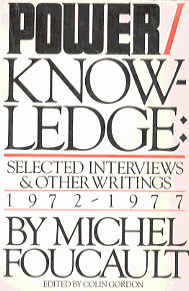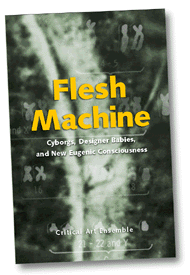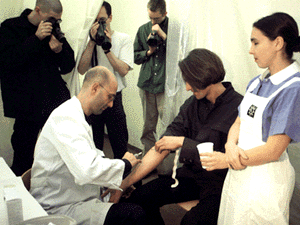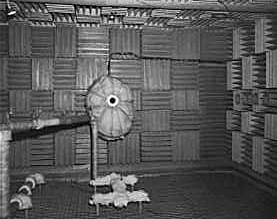III
James Hugunin
Unlike the conquerors of the past, technologists are
relentless proselytizers, insisting that everyone must
become like them and bow down before the World
Wide Web. They often appear puzzled when others
find their precepts threatening or oppressive.
--Robert HirschTechnocultures do not employ technologies for pragmatic
reasons,but for social (or class) status and the 'spectacular'
effects that shape experience.
-- Michael Menser and Stanley AronowitzThere is a growing awareness that there is something intrinsically
wrong with the very nature of contemporary science and technology....
Reductionism, the dominant method of modern science, is leading
on the one hand, in physics, towrds meaninglessness, and on the
other, in biology, towards 'Social Darwinism' and eugenics.
--Opening lines of The Third World Network's Declaration:
"Modern Science in Crisis: A Third World Response"
Naturalized Knowledge.
What has been the gist of the discussion of science and technology in terms of digital photography? To answer this one needs to probe broader questions concerning the widespread claims for science. The dominant global player in the cultural milieu, science as well depends for its development upon technologies; however, this doesn't mean technology determines social organization or cultural production either. More accurately, it is techno-science's use of universal concepts that has come to dominate our practices as well as our narratives for the laws of science are perceived as unquestioningly. J.-F. Lyotard has pointed in The Postmodern Condition, science is ultimately a narrative on just how things stand and, hence, cannot be privileged over other narratives on some special objective basis. Therefore, the disciplinary rules of scientific discourse form a discursively constituted regime of truth interwoven with power. French critic Michel Foucault's borderland concept of knowledge/power and Donna Haraway's postmodernist concept of situated knowledge are both attempts to encompass this postmodern awareness of the social production of knowledge, naturalized knowledge is what the philosophers call it to distinguish it from its older metaphysical sense where knowing can be objective and absolute.

In terms of discussing the
Internet, Menser and Aronowitz's conception of technology means that we
must see that the Net's rhizomatic interconnectivity
may offer a
different sort of counterculture to emerge in the West; but what happens
if the milieu shifts from the West to China, ask Menser and Aronowitz,
where the term "network" has been associated with the government network
of spies and informers, a government that will own the new technologies?
"What good is the Net if the purveyors of power are the only ones who have
access to it?" [32]
The End of Photography as We Know It?
Again, I ask: What has been the gist of the discussion of science and technology in terms of digital photography? The discussion has been filled with notions of "progress" and "determination." In the February 1998 issue of the photographic monthly, Afterimage, a report titled "Bay Area Photography" is typical. Therein, art-writer Terri Cohn synopsizes various responses by Bay Area art world notables to the impact of the new digital technologies on art photography, its practice, exhibition, and collecting:- Sandra Phillips, curator at the San Francisco Museum of Modern Art, is reported to believe we are at the end of photography as we know it; affirming the modernist discourse of aesthetic innovation and boundary-pushing, she claimed that few major artists will still engage with the medium in traditional ways.
- According to Cohn, Deborah Klochko (Director of the Friends of Photography) agrees: we are at the beginning of a new era of photographic exploration. But the real challenges from the point of view of the arts organization, Klochko observes, will not be the new technology per se, but arts funding and using the collection of traditional photography in new ways, such as exploring the vernacular and folk traditions of the medium. [33]
- For Artweek editor Meredith Tromble, with her eye on the immediate art scene, digital photography is "the hot thing to watch."
- While Marine Gillette (Director of San Francisco Camerawork who, along with the late Jim Pomeroy, curated the important 1988 exhibition at Camerawork "Digital Photograhy: Captured Images, Volatile Memory, New Montage") pointed out the problem of the archival instability of IRIS prints. Phillips said that local collectors, as a response to the vanishing gelatin silver print and the archival problems of IRIS prints, will need to horde traditional photographic prints before they become rare and expensive items to acquire.
Appropriating Science.
But back in 1997, the Society for Photographic Education's official publication, Exposure (31:1/2), featured a more astute and critical look at the intersection of art and technology. Article titles such as "Techno-Dystopia" by Gary Nickard and "Points of Friction: Artists Critique Technology and Science" by Robert Hirsch set a tone in sync with that of Cook's NO CARRIER wherein technologies, nature, and culture are understood as all intertwined, knotted up together. Hirsch, the Director of CEPA Gallery in Buffalo, New York wrote that critique of the new techno-sciences may not always be best done using such technology:"One purpose of this issue is to provide an alternative view not only to the generally euphoric atmosphere which continues to surround the invention of human-made technologies, but also to introduce the possibility of other ways of addressing the issues surrounding digital image-making. Thus, not all of these artists use the new technologies as part of their critique. More interested in a conceptual approach than in mastering PhotoShop, they relate more to subject than to process." [34]The seemingly traditional, objective-looking photographic work of Catherine Wagner seen in her photobook Art & Science: Investigating Matter (1996) would appear to fit Hirsch's parameters. On disc two of a CD-ROM titled Photography in the 1990s: fifty porfolios (Wright State University Art Galleries, Dayton, OH,1996), Wagner claims her intent in recent work has been "to demystify science." In her book, Wagner photographs a myriad of laboratory apparatus from experiments involving AIDS research to the Human Genome Project. The latter is an eugenics-based endeavor to describe and sequence all the human genes so as to introduce the technological into the very production of humans. Sadie Plant in Zeros + Ones, sees this as "holding out the possibility of organisms purged of their aberrations and mutations, wayward genes or peculiarities"; yet this intervention into nature, I counter, also holds out the prospect of transgenic or morphed creatures which people our sci-fi novels and films these days. As machine code has permitted sound, imagery, and text to interact on the common plane of digital technology, so the unlocking of the genetic code will permit a promiscuity and entanglement of once separate entities on the biological and bio-machinic levels.
Given the official setting for these endeavors, these are projects might appear to be impartial biological research. But, of course, they are also vitally linked to socio-political issues in the areas of insurance, law, and the military. So as to point this out, Critical Art Ensemble's lecture/performance Flesh Machine critically addresses the myths of reproductive technologies. But how does Wagner's work deal with the issue?


Flesh Machine (1997)
Critical Art Ensemble:
Blood sample being taken from
certificate holder in Vienna.
The blood was used to extract
a DNA sample.
The
term "sterile" becomes a double-entendre in these photographs as Wagner's
lens reveals the "sterility" of sterile environments. Are we viewers to
then extrapolate to the belief in the "sterility of thought" at work in
these environments? As many of these environments imaged have to do with
genetic research, has Wagner set out to document our own "Brave New World?"
Or, rather than adversarial, are we to see a true interdisciplinary collaboration
here between artist and scientists? Afterall, technology is intertwined
with culture: photography is a science and science is an art.

Definitely Not Sterile
(1995, gelatin silver
print, 30-in. x 40-in.) Catherine
Wagner
In another collaboration between scientists and a cultural fieldworker -- a comparative study of physics labs made by Sharon Traweek, Director for the Center for Cultural Study of Science, Technology, and Medicine at UCLA -- Traweek mentions the unequal power relationships that obtained between herself, an anthropologist, and the international high-energy physicists that were her subjects: "The Asian, North American, and European physicists -- mostly men -- I study are obviously in a position to resist the attentions of this white woman. I 'study up,' to use Laura Nader's graphic phrase. We all know that physicists have more power -- intellectually, institutionally, financially, politically, and socially -- than anthropologists and historians." [35]
Meanwhile, photo-historian Cornelia Homburg's essay in Wagner's book puts her photographs into the historical context of photography (the invention of, and preferred tool used by, science). She mentions Thomas Eakins and Eadweard Muybridge's nineteenth-century photographic atlas of animal and human locomotion, Precisionist Charles Sheeler's heroic factories rendered both as paintings and photographs, Werner Mantz's mid-1920s photographs of an X-ray clinic, and gives a modernist, pro-science spin to Wagner's efforts by suggesting that: "Like [Bernice] Abbott, Catherine Wagner undertook her project of photographing science because she realized the fundamental impact of science on contemporary life." But Wagner has visually ignored the key fundamental impact of technology on contemporary science. Surprisingly, her book is devoid of any image showing a computer. This is especially odd given her focus on the Human Genome Project, since in gene research much is done via computer simulation and the "transgenic" potential of today's biology has already been imaginatively accomplished in computer "morphing." Hence, both Wagner's own apparatus (the camera) and the science's key took (the computer) have become the "blind-spots" of her gaze.
It seems to me that Wagner's imagery is intentionally ironic, indirect. One will choose to understand Wagner's work from any of the following points of view, depending upon what attitudes the viewer brings to the work and the textual context surrounding it:
- A deconstructing of science and instrumental reason; the role of the researcher in the production of knowledge (erased in academic accounts by a specific set of narrative devices) is suggested by the apparatus photographed; the "mess" of everyday labor in the lab implies a "situated knowledge."
- The artist as fascinated by the forms that surround scientific experimentation, much as Sheeler was fascinated by the clean form-follows-function lines of the modern factory.
- Or science roundly celebrated for its mysteries, triumphs and its supposed inevitable utopian impact on our future.
The work contains all three possible readings and the accompanying essays gently nudge us toward each. I can imagine the exhibition opening back in 1996 with pro-science and anti-science, artist and non-artist, members of the audience looking at the same work, yet decoding the show in very different ways. Because of this, I am reminded of the clever, playful photobook Evidence (Santa Cruz, CA: ClathworthyColorvues, 1977).

Anonymous photograph, Evidence
(1977)
compiled by Larry Sultan and
Mike Mandel
The Will to Virtuality.
The issue of indeterminacy (pro or con? or both) also plagues the debate over the new technologies today. Traditional "difference feminism" has taken science and technology to task for its masculinist bias and rationality and opposed to it feminine nuturing and intuition. Whereas the type of cyber-feminism voiced by Donna Haraway in "A Cyborg Manifesto" (1991) ("I would rather be a cyborg than a goddess") and by Sadie Plant in Zeros + Ones ("these are the barriers [art versus science] which the new syntheses and collaborations spawned by digital machines now undermine") claims that feminism cannot afford to be an anti-science metaphysics, a demonology of technology. Thus Haraway and Plant, attack the logocentric binaries of natural/artificial and emotion/reason that have supported the earlier feminist antipathy to science. All this is even made more confusing when it is claimed by techno-enthusiasts that we are already beyond good and evil, a state where there exists, as Kroker describes it in "Virtual Capitalism," a "perfect equivalency between the will to virtuality and the will to the (virtual) good." But maybe it's less an issue of being pro- or anti-technology, more a problem of "developing a critical perspective on the ethics of virtuality," as Kroker suggests. Our bid to escape our bodies into cyberspace, to sit in the ejection seat and pull the lever, he astutely observes, "does not relax the traditional human injunction to give primacy to the ethical ends of the technological purposes we choose (or the will to virtuality that chooses us)." [36] Moveover, as Martin Heidegger has argued in "The Question of Technology," there is "good" technology and a "bad" technology; in ancient Greece the poetic aspects of both the fine arts and technology in our sense of these concepts were subsumed under the single Greek term techne. Heidegger suggests that art is "good" technology, an "enframing" that lets what presences come forth as truth (i.e., an encoding that lets Being emerge as truth), rather than the "setting-upon," "regulating," and "securing" (i.e., the rape of nature and dehumanization of its inhabitants) that characterizes the "bad" techne. Art -- understood now as a form of postmodernist aesthetic practice as prefigured by Bakhtin and touted Barthes, Foucault, and Lyotard -- may bring us hope in the form of complexity, multiple meanings and voices. As the poet Hölderlin (cited by Heidegger upon making his point about technology's Janus-face) wrote:I see the various essays and artworks included in this issue situated "where danger is," striving to be "the saving power also."But where danger is, grows
The saving power also [37]
---The End--
